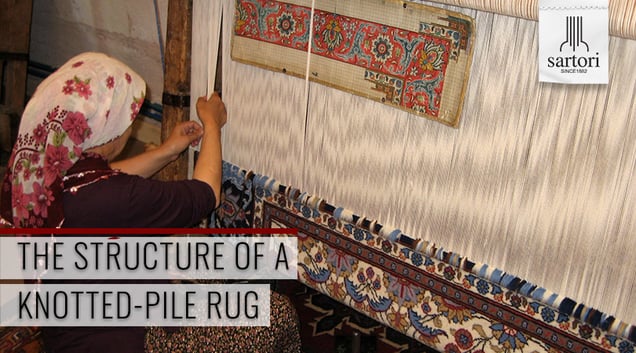
Rugs have become an everyday object that is now a décor feature in all our homes, but how can we choose the best ones, given the huge range of types on the market?
Understanding how a rug is made can undoubtedly help us not only to choose one of the best, but also to get an idea of the lengthy process behind it and the work that goes into it.
Let’s start with the most important element, which is the “bones” of the carpet: the warp.

The warp must be created with absolute precision, in particular to avoid buckling or bumps. The materials most widely used for the warp are cotton and wool, particularly suitable for their resistance and durability.
The warp is formed by vertical yarns that are wound around the loom. The horizontal yarns woven through the warp are known as the weft. The weft should not be visible on the top side of the rug, and can be seen mostly on the back

On the top side of the rug, the warp is covered by the pile and the knots.
The pile is the upper layer of a rug, perpendicular to the warp. It is formed by shearing the loops of the knots. The shearing process is very important at this stage; it must be even, otherwise the patterns will not be clearly visible. The pile determines the thickness of the rug, an important factor to consider depending on where the rug is to be placed.

Each rug is formed by thousands, sometimes millions, of individual knots. Each knot contributes to the pattern of the rug, just as every single pixel forms the screen you’re reading this article on.
There are essentially two types of knots: symmetrical and asymmetrical.
The former is also known as a Turkish knot, and the latter as a Persian knot. The symmetrical knot is ideal for geometric patterns, while the asymmetrical knot is perfect for winding and floral patterns.

Lastly, the selvedges are the parts of the warp where the knots are fixed: the end of the rug. Rug makers adopt a number of techniques to boost resistance: some twist the warp yarns together, some gather them into bunches, and others repeatedly wind the weft and warp yarns together. The selvedges can be round or flat.
Examining how a rug is made can help us understand the importance of this fine object.
Discover all the secrets to furnish your home with the perfect rugs: download our free guide!


